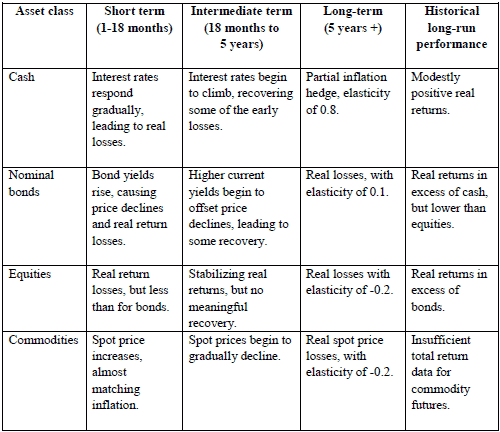Hedging Inflation
Post on: 2 Июль, 2015 No Comment

Follow Comments Following Comments Unfollow Comments
Last week I described the challenge of inflation, which has the potential to erode investors’ purchasing power and investment returns each year, Fighting Inflation with Your Portfolio . This week I’ll discuss how rising consumer prices tend to affect different asset classes within a portfolio, and which ones may be most helpful in offering some measure of inflation protection for investors.
The Trouble with Bonds
As fixed income securities, conventional bonds are negatively correlated with inflation, meaning they are adversely impacted by consumer price increases. We looked back over the 15 years from January 1, 1997 to December 31, 2011 and found that fixed income securities, as measured by the Barclays Capital US Aggregate Bond Index, had a -0.17 correlation with inflation (see chart below).
In addition, today’s bond yields are suppressed by the Federal Reserve Board’s policy of maintaining rock-bottom short-term interest rates. For instance, if you purchase a 10-year Treasury and hold it until maturity you are locking in an annualized nominal return of approximately 2%, or 1.3% on an after-tax basis, assuming a 35% federal tax rate. Even if inflation is only 2% during that period (and inflation averaged 2.99% from January 1, 1926-December 31, 2011, according to Ibbotson), that’s a negative return in real terms.
Unlike fixed income securities, stocks can potentially offer some protection against inflation since companies are to a greater or lesser extent able to raise prices (i.e. pass on rising costs to their customers). Thus, earnings tend to increase with inflation. In fact, over the very long term, the return on stocks has been relatively insensitive to realized inflation rates. According to the Ibbotson data from 1926-2011, the S&P 500 index returned 9.78% annualized, or nearly seven percentage points ahead of consumer price inflation.
Inflation-Fighting Toolkit
What about other asset classes? We looked to see which had nominal returns with positive correlations with inflation from January 1, 1997-December 31, 2011, implying that they preserve purchasing power during periods of inflation. Some of the usual inflation-fighters scored well—and there were a couple of surprises.

Inflation-indexed bonds had a positive correlation with inflation (0.08). Treasury Inflation- Protected Securities (aka TIPS) and other nations’ inflation-indexed bonds are structurally linked to rising prices in that governments periodically adjust the face value, or principal, of the bonds to reflect consumer price movements.
Commodities (as represented by the Dow Jones-UBS Commodity Index), another possible alternative asset class in the inflation fighter’s toolkit, scored even better, with a 0.25 correlation with inflation over the 15-year period. Unlike stocks and bonds, commodity returns tend to increase in periods of unexpected surges in inflation. REITs, another traditional inflation-hedging asset class, had a modestly positive 0.08 inflation correlation. Gold, traditionally seen as an inflation hedge, showed only a modest correlation of 0.04 with inflation. In recent years, demand for gold has been stoked by a proliferation of new investment vehicles available to retail investors, such as gold exchange-traded funds.
Now for the inflation-hedging surprises: bank loans and high-yield debt, two asset classes not normally associated with inflation protection, scored very well. In fact, bank (or leveraged) loans, at 0.32, had the highest correlation with the US consumer price index of all the asset classes we surveyed. When you think about it, it’s not so surprising. These are floating-rate loans, so if inflation and interest rates tick up, banks have the ability to raise rates (typically quarterly) on the loans outstanding.
High-yield (aka junk) bonds have fixed rates, yet with a correlation of 0.10, appear to have provided inflation protection. Junk bonds, which typically trade like stocks, are helped when spreads between high -yield and high- quality (such as Treasury) bonds narrow, which typically happens when inflation heats up. Of course, bank loans and junk bonds are asset classes that should be handled with care. For that matter, which–if any–of these alternative asset classes belong in your portfolio will depend on your individual circumstances.














